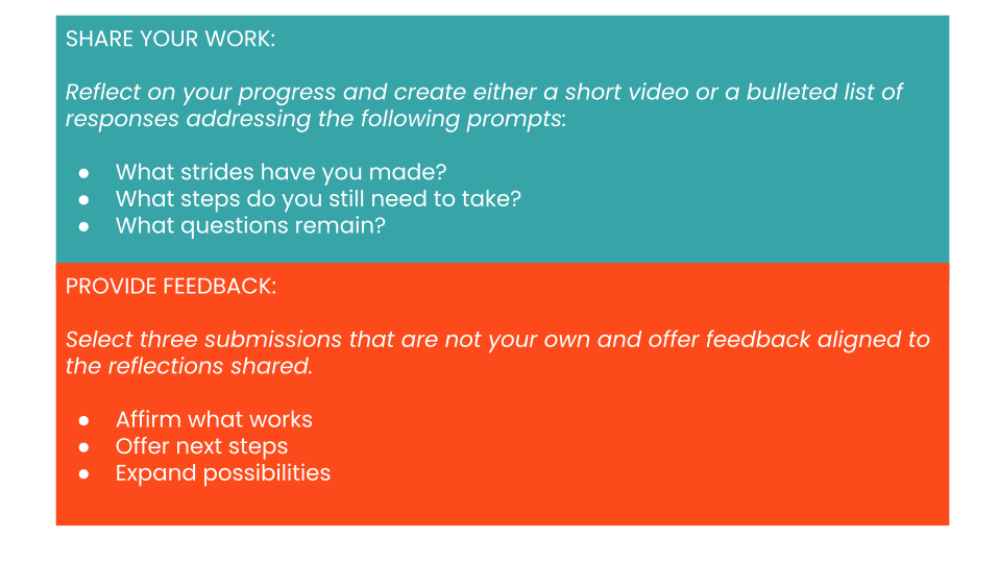Why Making Educator Work Visible Matters
There’s power in making learning visible.
In the last 18 months, challenges have emerged in how teachers continue to do that for their students. As classrooms transitioned between in-person and online, teachers had to shift tools and strategies to continue to make student work visible for their learners no matter where they were learning from. Across this last year, teachers had to adapt how students see and engage in one another’s work.
How are teachers adapting to see and engage in their colleagues’ work too?
At GOA, we believe in the value of both students and teachers making their learning visible for one another. When we elevate the work of educators and create spaces for educators to tell their own learning stories and to share their artifacts of learning, we make room for both community connections and professional growth.
Visible Work = Community Connections
In our Design Institutes this June, educators from schools around the world joined to participate in an intensive five day design experience. Representing Pre-K to higher education, instructional coaches, classroom teachers, and administrators, everyone was invited to share their daily progress on thematic design tasks.
With frameworks to guide both posts and replies, participants shared their work. Rough drafts were encouraged; these were not sharing spaces for polished perfection but for works-in-progress. Educators used their work samples as a launching point for questions, inspiration, and support. Across the five days, through conversations focused on their own evidence for learning, the participant community gained insights on one another’s classrooms and approaches. They celebrated what they were trying, wondering, and accomplishing. They traded resources, ideas, and celebrations. They took collective risks together, sharing in the vulnerable process of making rough drafts visible. Though most of them had never met in person, they operated as a community, supporting one another in their individual learning endeavors. Their work and their feedback deepened both learning and community connections:
After posting a choice board she’d designed, Ngan Ta (‘Iolani School, Hawaii, USA) shared a question with the participant community. Exchanges like the excerpt below between her and Yifan Xu (The Pingry School, New Jersey, USA) exemplify the collaborative spirit that grew through shared work.

Visible artifacts can serve as starting points for meaningful collaboration. We know that collaborative classrooms support student well-being. Collaborative educator communities support teacher well-being too.
How might we create space in our schools to share works-in-progress? Use frameworks for sharing. Protocols provide equitable entry points for colleagues to talk about their work with the safety of clear expectations.
Visible Work = Professional Growth
Pandemic learning shifted our ability to look over our colleagues’ shoulders and walk through their classrooms. Informal opportunities to support and inspire one another shifted. When we take deliberate steps to make learning visible, we do more than just cheer one another on and get to know one another; we co-curate a body of exemplars that drive shared innovation and inspiration. We create space to see one another’s professional practice. We participate in communities focused on growth. As the conversation between Ngan and Yifan showed above, feedback on work can grow into exchanges on shared learning, borrowed resources, and future goals. We know that feedback drives student learning. Feedback impacts teacher learning too. And just like with students, clear feedback prompts help teachers access conversations. In our Design Institutes, we offered a framework for posting and responding to work:

The sharing spaces across Design Institutes quickly grew as participants collectively tried new approaches, made their work visible, and extended one another’s learnings. By the end of the week all educators had curated portfolios of work with immediate application to classroom practice. They also left with next steps in mind for future design goals. On our final day, we told our learning stories in short video reflections, walking one another through what we’d created and what we hoped to do next. By making work visible, offering frameworks for feedback, and supporting design work in community, educators were equipped to take on professional learning goals and to focus on strategically improving student learning.
Evan Story (Town School, California, USA) reflected on his five day experience, sharing this short video on Friday. He focused on designing a process portfolio and reflects on his gains during the week and how feedback informed his revisions and next steps.
How might we make exemplars and learning stories visible to support one another’s professional growth? How might we design opportunities for colleagues to give and receive feedback on what they are trying? Invite professional learning communities to center conversations on evidence for learning.
Make Your Work Visible
GOA is committed to creating spaces for educators to design and share. We believe in the power of centering conversations on educator and student work to provide opportunities for connections and growth. We also recognize that time is a limited resource and that design work requires it. Our upcoming Sprint courses are structured in response to educators’ limited time. They are action-oriented, offering condensed design sprints with immediate classroom impact and featuring sharing spaces where participants co-curate artifacts to keep educator learning visible.
Our first Sprint course, Setting Up Gradebooks, launches August 17 and offers sprints in gradebook set up, reassessment policy, and rubric design. Register here.
